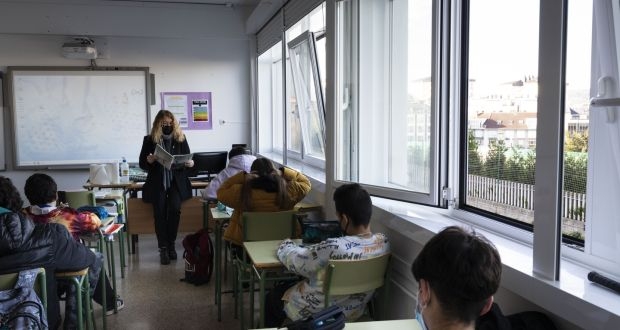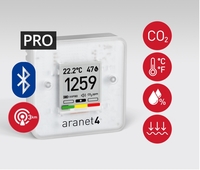Fresh Air is Vital to Keeping Schools Safe. Is Opening Windows Enough?
 Original Article In: The Irish Time by Sylvia Thompson (30th March 2021)
Original Article In: The Irish Time by Sylvia Thompson (30th March 2021)Parents and teachers have raised questions about the quality of ventilation in classrooms to protect against Covid-19
As primary and secondary school students return to class after the third and most devastating wave of Covid-19 in Ireland, our attention turns yet again to how to keep schools as safe as possible for students and staff alike.
It is now widely understood that Covid-19 spreads more easily indoors with some experts saying that the risk of breathing in virus infected particles is 20 times higher indoors.
So-called aerosol particles which are smaller and lighter than respiratory droplets remain in the atmosphere for much longer leaving classrooms full of students a potentially high risk environment when a student or staff member is unaware that they have Covid-19 and is unwittingly spreading it.
The Department of Education has issued detailed guidance to schools on good ventilation practices. These include having windows open as fully as possible when classrooms are not in use (eg during break-times and lunchtimes and after school finishes) and partially opened when classrooms are in use. The same advice applies to staffrooms, gyms, libraries and toilets.
“Schools should also ensure that all permanent ventilation openings in rooms are fully open and not blocked by wall hangings, etc and all mechanical ventilation or air conditioning systems should be set to 100 per cent fresh air,” the document issued in November 2020 states.
Teachers are advised to also keep internal doors into classrooms open for periods of time to help increase air movement and ventilation rate.
Anyone who has school-going age children will know that open windows and doors have become the norm during the pandemic (with many students keeping jackets and coats on during class) but some experts are now suggesting air quality monitors should be an additional tool to monitor indoor air quality in high occupancy buildings such as schools.
Orla Hegarty, the Assistant Professor at the School of Architecture at University College Dublin has been a vocal critic of the lack of attention paid to indoor aerosol transmission of Covid-19 by public health officials. “It is now believed that most spread of Covid-19 is airborne, that there is no safe distance in a poorly ventilated room and that conditions can move from low to high-risk within 15 minutes,” she wrote in an Irish Times opinion piece on the topic.
Recent outbreaks of Covid-19 which originated in hotels used for quarantining in Australia have been attributed to airborne spread of the disease. According to experts, the security guard who caught the UK strain of Covid-19 in Perth recently is mostly likely to have caught the virus from air flow into the corridor from under the room door or when the door was opened. Officials have since advised security guards working in quarantining hotels to wear masks all the time when on duty.
While the wearing of masks is mandatory for secondary school students, primary school children don’t have to wear face coverings unlike their counterparts in many European countries where children as young as six wear masks to school.
Orla Hegarty and Dr Cliona Ni Cheallaigh, Infectious Disease Consultant at St James Hospital are among those who have joined air pollution scientists in calling for the installation of carbon dioxide monitors in classrooms to keep a check on air quality by giving clear indication when classrooms are stuffy and therefore should be evacuated. Acting as a proxy for the virus, these devises operate on a traffic light system where green means the air quality is good, yellow means it is getting worse and red means the air is stale and the room is no longer suitable for people to stay in.
John Wegner, Professor of Chemistry at University College Cork has also emphasised the significance of airborne transmission of Covid-19 and the use of carbon dioxide monitors to keep a check on the air quality in classrooms.
“Carbon dioxide monitors with a traffic light system, which are equipped with non-dispersive infrared (NDIR) sensors are cost-effective and can help remind teachers to act by opening windows when levels get too high (usually above 800-1,000 parts per million),” Prof Wenger said in a recent article about classroom ventilation in Passive House magazine.
“Installing good ventilation systems in schools would ensure a healthier environment for everyone, better academic performance and hopefully better energy efficiency as well,” said Prof Wenger.
The American Environmental Protection Agency (EPA) held a seminar on how to prioritise indoor air quality in schools on February 25. At the seminar, experts advised schools to assess the effectiveness of filtration, ventilation and system monitoring in schools.
The American EPA has detailed guidelines on indoor air quality in schools. And leaving Covid-19 aside for a moment, these guidelines stress the long and short term health effects of poor indoor air quality for staff and students. These include coughing, eye irritation, headaches, allergic reactions, aggravating asthma and other respiratory illnesses and in rare cases, contributing to life-threatening conditions such as Legionnaires Disease or Carbon Monoxide poisoning.
The American EPA guidelines which looks at contaminants such as mould, radon and second hand smoke, have an indoor air quality Tools for Schools Action Kit. They also stress the importance of protecting indoor air quality during school energy efficiency retrofits – an issue which is vital for Irish schools too.
Speaking at a webinar on the safe re-opening of schools organised by the Independent Scientific Advocacy Group (ISAG), Dr Gabriel Scally said that in New York, parents can assess information on ventilation of their children’s classrooms. “Ventilation is absolutely crucial in the suite of measures alongside training on hand washing, cough etiquette, the availability of soap, paper towels, wash stations and hand sanitisers and sick people should not be at school,” said Dr Scally. He said he would also like to see better ventilated areas and larger spaces – community buildings or marquees in playing fields – so students could be spaced out more to reduce aerosol transmission of Covid-19.
The Department of Education guidelines on ventilation for schools state that is not necessary to install carbon dioxide monitors in classrooms when the other advice on ventilation (windows open fully outside class time and partially opened during classes) is followed.
“It is the Department’s view that …windows are likely to be required to be open at a frequency and level… to ensure appropriate levels of ventilation in the classroom irrespective of whether the opening of windows is prompted through the indoor air quality monitor or through the pro-active approach,” the guidelines state.
The UK Scientific Advisory Group for Emergencies (SAGE) said it had “low confidence that continuous monitoring of carbon dioxide may be a possible use as a transmission risk indicator” adding that further research is necessary “to evaluate the potential application of the approach for different spaces and to compare modelling results and actual infection rates.”
The elephant in the room is however how cold classrooms become with windows open and some teachers have already expressed interest to buying carbon dioxide monitors to guide them as to when windows need to be opened or not.
On a more optimistic note, Spring weather will mean that having windows open in classrooms will not been as uncomfortable as during winter months for students and teachers alike.
And going forward, it must be remembered that good indoor air quality is not only an issue for reducing the potential spread of viruses but that a classroom with a flow of fresh air also improve children’s attention, concentration and ability to remember.
International indoor air quality experts agree that maintaining high standards for indoor air quality should be a high priority for all schools as we emerge from the Covid-19 pandemic.
How stuffy are our classrooms?
Health Protection Surveillance Centre guidance for schools which rely on natural ventilation advises that windows should be opened when CO2 levels reach 800 part per million (ppm).
Research by an Irish start-up company, Ziggy Tec, into air quality in classrooms at three schools in Dublin (two secondary, one primary) from mid-October to December 2020 found:
- 82 per cent: the amount of time that the 800ppm threshold was exceeded.
- 1062ppm: the average CO2 levels recorded in classrooms.
- 3,803 ppm: the maximum CO2 level recorded .
Ask A Question




 Aranet4 Home
Aranet4 Home Aranet4 Home with Large Display
Aranet4 Home with Large Display Aranet4 Pro
Aranet4 Pro